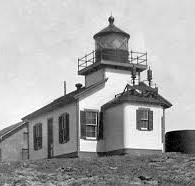The lighthouse is on Point Arguello, located in Santa Barbara County, California. It serves the Santa Barbara channel, Gaviota Coast, joining Vanderuberg Space Force Base near the city of Lompoc, California. The original lighthouse was built in 1901 and had a white square tower above the keeper’s house. It had a fourth Fresnel lens that was transferred from the Point Hueneme Lighthouse. In 1934, the tower was replaced by a square pyramidal skeletal steel tower.
In 1911, due to erosion, it was replaced with a stand alone tower. During World War Two, the Coast Guard had manned Point Arguello light and Point Arguello Lifeboat Station. In 1958, Point Arguello Lifeboat Station was retired.

The history of Point Arguello had been one of several shipwrecks. The area was named “Graveyard of the Pacific.” The most famous incident was the wreck of the Yankee Blade, which occurred on October 1, 1854, when this steamship hit rocks 200-300 yards offshore. The number of people lost was 415. In 1911, the Santa Rosa ran aground at Saddle Rock, north of the lighthouse, just after the third officer thought it was a railroad construction light for the lighthouse.
In 1923, on September 8th, the U.S. Navy Captain Edward Watson sailed in a thick fog that shrouded the California coast. He was in command of a flotilla with 14 destroyers heading southward from San Francisco en route to a navy base at San Diego.
The ship would soon be making a wide eastward turn around the Point Arguello and Conception area, as he believed. He tried to look into the dense fog to find the lighthouse beacons, but he never saw the lights. As he maintained exact military formation, each destroyer ran one behind the other. Watson was a decisive commander. His radio man received conflicting electronic signals from Point Arguello. It revealed the lead ship Delphy was north of the point. What lay to the east wasn’t safe. It was not the water of the Santa Barbara, but a solid wall of rocks. Another radio signal indicated the flotilla was about to enter the channel. Captain Watson made the wrong decision. He ignored the radio signals and relied on the old sailor’s instinct by using dead reckoning. He plotted the course. He relayed the information to the other ships. They all turned to port. His flotilla was far from the channel. The Delphy struck, hitting the coast located at a place called “Honda.” One by one, the Lee, Young, Woodbury, Chauncey, Fuller, and Nicholas followed along to destruction. The other ships managed to bear off just in time to save themselves. The pounding surf tore the ships apart.
Twenty-three sailors perished. Rescue workers, organized by the keepers from the lighhouse, saved others from death. The keepers, Gotford Olson, Aruel Settles, and Jesse Mygrants went into action. They dragged the shipwrecked sailors to safety. The injured were taken to the lighthouse and cared for. Medicines and food were brought to the beach below, where men were in small groups. This went all night long. Having risked their lives, the keepers received official commendations from the Navy. An anchor was set up on the nearby cliff for a memorial for the men who died at Honda.
The Point Arguello Light Station in 1901 was built on a barren cliff about 100 feet above the Pacific Ocean. It remained in operation until 1934 and was replaced with an automated light on an iron-skeleton tower.
Coordinates: 34º 34 37.4 N. 120º 38”49.9 W
Tower: 1901 First
1934 Second.
The light itself is 124 feet above the water. A two-tone diaphone fog signal is placed in operation when visibility is less than 5 miles. The diaphone, when operating, is synchronized with a radio beacon every three minutes for distance finding.
(Point Arguello Light- Wikipedia)
Head Keepers:
William A. Beeman (1900-1908)
William A. Henderson (1908-1913)
George A. Hussey (1915)
Gottfrid Theodor Olson (1917-1930)
Leo Y. Kellogg (1941-1948)
